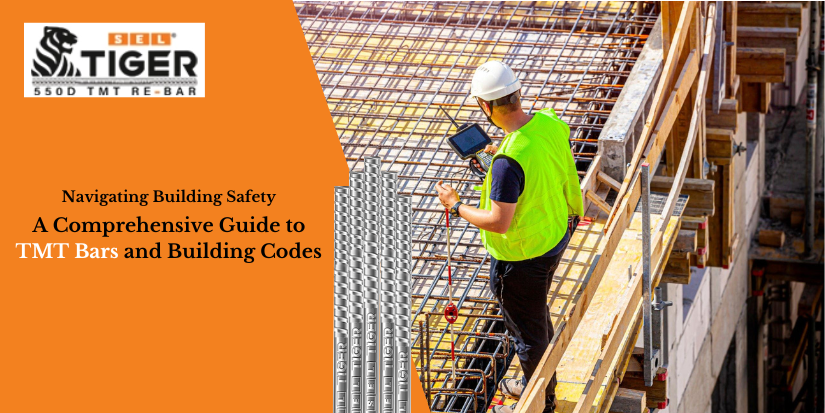
The real estate market is booming with new and modern construction, as we see the rise of modern and advanced construction, we must comprehend that safety is of paramount concern in construction. The role of architects and builders is not only limited to laying a robust foundation to exude strength and durability but also complying with the building codes of that area. TMT (Thermo-Mechanically Treated) bars are a crucial component that is pivotal in ensuring structural integrity. These rebars are reinforced concrete, counteracting the tensile forces which occur due to twisting, bending and stretching. As we navigate building safety, it is important to know how TMT bars play a key role in integrating building codes in the construction of modern buildings.
Thermomechanically treated bars are a type of reinforcement bars which are commonly used in construction projects. These bars are manufactured by quenching, self-tempering, and atmospheric cooling. This process imparts superior quality, and adds flexibility to the rebars, making them an excellent choice for building construction.
As a leading Fe 550D TMT bar manufacturer we use a billet formed from Primary Steel, which is then processed through Thermex Technology. The processing machinery consists of a cooling chamber. The rapid cooling converts the outer layer of the Fe 550D TMT bar into hardened structures, while the inner core remains soft. The combination of this hardness and softness gives the TMT their unique properties.
So, what role does the TMT bar play in building safety, and how does it comply with building codes?
For the construction of any high-rise residential/commercial building, we have the National Building Code of India (NBC). It is a crucial document for building structures, ensuring health and safety for occupants and the public.
The codes outline the minimum requirements for construction practices, materials and structural design. Adhering to the set rules and standards is not only a legal requirement but also a fundamental responsibility of the architect, so they can prevent potential hazards in future.
Understanding the rules set by NBC helps in identifying the right building material which not only meets but exceeds the expectations. Choosing Fe 550 D grade TMT bar which are typically certified by National and International bodies are safer than locally manufactured steel bars made of scrape iron.
The NBC mandates provision to use building materials which have fire-resistant properties and can compartmentalise fire to prevent the spread. As TMT bars are fire-retardant, and have high heat resistance, they do not catch fire and spread it in the building.
The high tensile strength of TMT bars allows them to withstand heavy loads and forces exerted on buildings. They have a higher yield strength compared to other types of reinforcement bars, making them less prone to bending or breaking under stress. This strength ensures that structures built with TMT bars can withstand earthquakes, wind loads, and other external forces.
For safety and security reasons NBC upholds the highest standards of protection, this includes using construction material that enhances structural integrity. TMT bars exhibit excellent ductility which means they won’t fracture or deform, this property is vital in seismic zones where buildings need to absorb and dissipate the energy generated during an earthquake.
You May Read: How to build a strong building foundation? Useful insights on the use of TMT bars
As we navigate through the building safety codes, we understand safety cannot be compromised, and this is what we believe with our Tiger Bond. TMT bar manufactured at the integrated manufacturing unit of S-E-L makes the TMT bar strong enough to withstand situations which can weaken the structure, and pose a threat to the construction.
Before putting our TMT bar on the market, we conduct thorough testing that includes various parameters such as Yield Stress, Ultimate Tensile Strength, and Elongation Strength. These criteria or parameters help in identifying the capability of the TMT bar. As a leading Fe 550D TMT bar manufacturer our TMT bars are tested in one of the stringent testing laboratories, which is reflected in our esteemed certification from renowned institutes of the industry.
S-E-L TMT bar is NABL accredited as per ISO/IEC 17025:2005. We have macro etching tests which are done to ensure the proper use of thermal treatment, along with that we use advanced UTM standards to check proof stress, elongation, and bendability tests.
According to the zonal building code of practice, as per the land, the construction should be done. For zones prone to seismic activities we have earthquake-resistant rebars as it consists of a balanced proportion of Manganese and Carbon.
While choosing TMT bars for construction, it is important to know the safety compliances and building codes beforehand, as it helps you in the selection of the right material. Thermomechanically treated bars with their high strength meet the mandate of structural integrity to provide safety and security to occupants. S-E-L Tiger TMT bar has the Tiger Bond, which it creates with the concrete, helps to prevent cracks, increase load-bearing capacity, and ensure structural stability for the longevity of a building.
In building construction there is a role of various grades of TMT bars, each denoting its strength and ductility. Common grades of TMT bars include Fe 415, Fe 500, Fe 550, and Fe 550D, where the numeric value represents the yield strength, and D represents “ductility”. Where Fe 415 is commonly used for making slabs, and stairs, Fe 550D are useful in building the framework and pillars of the building.
To ensure structural safety, use TMT bars which are certified by National and International bodies. Verify that the bars meet the relevant standards and specifications according to the zonal building rules.
A TMT bar must be earthquake-resistant, fire-resistant, corrosion-resistant, ductile and flexible to comply with building codes for safety.